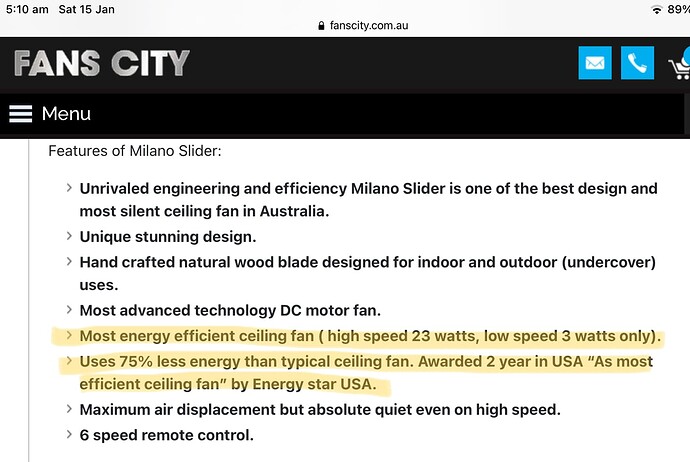Welcome @ScoutCo.
Other consumers now have an opportunity to consider the feedback provided.
For paid Choice members there are comparisons in the Choice reviews of a wide range of fan types and styles. We are looking to replace our ceiling fans and considered the Milano option,
As a general observation.
All our current ceiling fans are AC. The Milano fans are way outside of the budget for our needs. Looking to similar performing fans in the reviews, we were able to select at least another 5 to look to as replacements. A possible justification is newer DC fans may consume less power and have more speeds. 6 vs 3 for those we are looking at.
Of the alternatives all are significantly less expensive than the Milano Junior. The difference between fans by noise levels are insignificant, with one exception. Styling varied. We have higher ceilings, hence the option of an extension rod is also important. All the fans have lights.
We thought the more expensive fans may be justified on power savings. As part of their promotional material Fan City
It’s a little confusing as in the Choice reviews the 5 lower cost fans all consume less energy annually. I don’t think the Milano would be a poor choice. It’s just no better at saving energy than the alternatives.
Choice Team Note:
For the Choice review team please note the differences between the as tested 5W to 30W power consumption and power indicated in the marketing material. The suppliers spec sheets are also different. @BrendanMays
P.S. On the Energy Star award which is a US system.
The Milano Junior Slider 50” fan award noted by Fan City needs further clarification. 599 ceiling fans available in the US Market share an ‘Energy Star Certified’ and an ‘Energy Star Most Efficient’ rating. Is it a formal award? My reading it’s a certification that says it’s not inefficient.
Optimistically Fan City’s marketing might be puffery. It’s possibly misleading consumers.
Is the Milano Junior Slider the most energy efficient 50” fan available. It’s one way to read the promotional material. It’s difficult to determine the full facts. The brand of Milano is not listed in the Energy Star certifications. Although the same manufacturer may sell to a US importer using a different branding or model?
The following link will take consumers to the website. Every fan model tested has a numerical fan efficiency score. They vary significantly, hence certification is more a pass fail than a best in class award. It’s not evident how relevant the certification is to product imported and sold in Australia. It is possible to sort the fans rated by efficiency from the US test results,
The US Energy Star system is not promoted broadly to Australian consumers. It’s open to argue it should not be referred to as most consumers will not be familiar with it or how to use it. Should the ACCC have an opinion on it’s use in marketing products?

